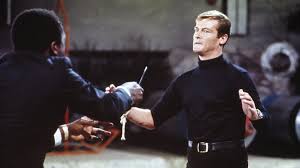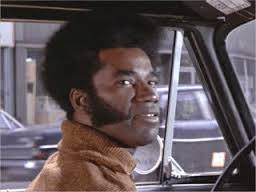
Yes, yes I know it’s not a new release – I was three when it came out. But it was Roger Moore’s first outing as James Bond and now Sir Roger has died I find myself drawn to this movie more than his others, even ‘The Spy Who Loved Me’, my default favourite of his Bond films.

Another reason for inclusion in this blog is that of all the Bond movies it’s the only one that is a bona fide fantasy story. However much Bond sneers at Solitaire’s powers of prediction, there is no denying her power works. There’s a sequence early on with her placing Tarot cards, superimposed over a shot of Bond’s plane landing. ‘A man comes,’ she says in her sonorous, dreamy English tones. ‘He brings violence’. Of course he does, he’s James bloody Bond, but this little sequence is unlike any other in the canon. It’s a brilliantly imagined piece of filmic fantasy for one thing, and for another is one of those chills-up-the-spine moments near the beginning of a Bond film that lets the viewer know how things are going to go, but in a unique and original way.

Solitaire herself, played by Jane Seymour, is breathtakingly beautiful. One expects that with Bond girls, but there is something timeless about Seymour in this role. It’s as much to do with her under-rated charisma at it is that extraordinary face and long, chestnut hair that’s pretty much a character in itself. There is tragedy in her story; one of a long line of ‘seers’ employed, or perhaps ‘owned’, by the film’s villain, Kananga, Solitaire predicts the narrative’s turning points with uncanny accuracy. Only the act of love will undo her power, and Bond is never as loathsome as when he cheats her into bed, leaving her helpless and undone: as much a commodity for Bond and his masters as she was for Kananga. On more than one occasion, she is referred to as baggage, or ‘that’ by both Bond and Kananga. Unlike Kananga, Bond stops short of thumping Solitaire, but it still makes for uncomfortable viewing.

Therein lies the problem with this film: it is half brilliant and half awful, probably more so than any other Bond movie. Take the title music. The orchestrations are incredible, from the greatest fanfare this side of John Williams’s ‘Star Wars’ theme to the follow-on resolution, which expresses a kind of hysteria using borderline discord that perfectly captures that voodoo terror. Then there’s the naff Casio keyboard bit and the sort of dire McCartney back-of-a-beer-mat lyrics that have you skipping forward on Beatles albums.

Bond himself is a similar mismatch. Some of Roger Moore’s greatest quips are in this film and they’re so good I’m going to include a couple here:
[Bond realises that cigarette lighter in the CIA car is a communications device]
Ah. A genuine Felix Leiter.
[CIA contact Rosie gets flummoxed in Bond’s hotel room]
Don’t worry, I’ll soon lick you into shape.
Only Moore could have got away with gags like these. At forty-six he still looked young enough to be believable in the part, and hadn’t yet eased into the parody of his later films. He’s slim, and elegant; you believe this is a man who has a change of clothes built into his outfit just so he can break into an enemy complex on a hang glider while smoking a massive cigar.

What you don’t believe is that he will shoot a woman in the face from point-blank range after having sex with her, which is what he threatens to do with Rosie (Gloria Hendry), the movie’s other Bond girl. Like Solitaire, Rosie looks incredible, but any character complexity is down to the actress rather than the writing. Despite being a double-agent for both the CIA and Kananga, Rosie is in a constant state of near panic that leads her to make rookie errors. It’s hard to understand why Kananga, who is more believably intelligent than many Bond villains, would risk such a vital mission with someone so incompetent. That said, it’s a wrench when Rosie is shot in the back and Bond finds her with her eyes wide with shock and grief.

It’s Kananga who kills her, via one of the voodoo effigies that guard the island. Kananga is one of my favourite Bond villains, not least because he has brilliant assets. One is his master plan. He is the governor of a Caribbean island and also, in disguise, a New York criminal mastermind. He grows heroin on the island, disguised under netting, and keeps the island’s population under control by playing on voodoo superstition. The drugs are then shipped to America, where he oversees distribution. He plans to flood the US with free heroin, get everyone hooked, then up his price and destroy the existing mafia. If ever there was an accurate metaphor for the western capitalist establishment, it’s that.

Kananga is a genuinely curious mix: a practical man who bases his successful empire on the predictions of seers like Solitaire. Kananga is not a caricature of the mastermind who was to become all too over-familiar in years to come, he is thoughtful and watchful; characterisation helped in no small part by his depiction by Yaphet Kotto, who would find even greater success six years later as the engineer in ‘Alien’.

Kotto has a dense, brutal physicality that is the opposite of Moore’s; however, while you sense that Moore’s Bond isn’t always engaged with his surroundings, Kotto’s Kananga is a man restraining great and dangerous power. His voice is amazing; in later roles like TV’s ‘Homicide’ it would become so gravelly you worried about him getting the words out at all; here his eloquence is even more impressive in that you feel he is playing with it, but with effort.

Kananga has great sidekicks too. Odd Job in ‘Goldfinger’ is a silent lug you end up hating when he kills Tilly, while Knick-Knack in ‘The Man With the Golden Gun’ is a comedy midget. Kananga’s sidekick Tee-Hee (Julius Harris) is a level above either of these. With his urbane manner, smart suit and conservative shades, he could be an estate agent except that due to an unfortunate crocodile incident he now has a steel arm and a claw. The claw is clearly a bit of rubbish puppetry that extends out of his sleeve far longer than it should, but does not detract from Harris being almost as suave as Moore.

Kananga’s other sidekick is the terrifying Baron Samedi (Geoffrey Holder), the man who cannot be killed. Gleefully malevolent, eerily polite and with a camp grace entirely his own, Samedi is the other character who places ‘Live and Let Die’ firmly in the realm of proper fantasy. He retains his predictive power when Solitaire loses hers, pulling the correct Tarot card from the pack and showing it to her, his face a study in aloof contempt. Like all the villains in this film, he never loses his sense of humour, his immortal laughter ringing out just before the credits rise.

Even if you haven’t seen the film, and despite my reservations you should, you’ll have gathered that the antagonists are all black characters. This aspect of ‘Live and Let Die’ is another one in its favour; I can’t think of another popular film of the time – or since, for that matter – with a cast like this one. Yes, many of them are the villains, but so what? A story is defined by its villains and these guys are simply great. They have charisma, relevance and most of all agency. It’s a key difference between Fleming’s novel and the film. In the book, Kananga works for SMERSH, the Russian intelligence organisation. Indeed, ‘From Russian With Love’ details SMERSH’s attempt to get revenge on Bond for consistently screwing up their operations, including the one involving Kananga. In the film, there is none of that.

Its black community is the true reason I come back to this film. Where else do you get a genuine look at early 1970s Harlem as part of a popular movie franchise? There are loads of great jokes here too, from the insanely cheerful cabbie who constantly calls Bond ‘Jim’ to the funeral procession that’s part of a brilliantly ridiculous assassination (“Who’s funeral is this?” “Yours”).

‘Live and Let Die’ doesn’t rely on gadgets; an element of the movies that even as a kid I had less and less patience with. Bond has a silly Morse code hairbrush and something that finds bugs which looks like a one-button TV remote control at a time when nobody had them, but the most impressive gadget is Bond’s coffee machine. “Is that all it does?” snoots M after Bond spends what seems like hours making the perfect cappuccino. Bond’s magnetic watch is no use to him in one memorable moment when he tries to pull a boat towards him only to find it’s tied up. He later uses the top deck of a bus to incapacitate a police car; again it’s daft, but is something you can believe might just happen with the right degree of skill and outrageous courage.

Which brings us to the Sherriff, a man so grotesque he makes Jaws look like Miss Moneypenny. In fairness to the Sherriff, he calls everyone ‘boy’ regardless of race and is clearly not meant to be taken seriously; he destroys a fleet of police cars as thoroughly as Bond wrecks his pursuers during the interminable speedboat sequence. It’s still unpleasant though and the character returned in later Bond films, despite having no actual role other than ‘comedy’ value. He does have one good joke in this one; when Bond’s role as a spy is revealed, the Sherriff asks, “On whose side?”

The voodoo sequences are striking too, with details like the blessing by priests that give the ceremonies an authentic feel. Despite, or perhaps because of, the constant presence of threat and death, they feel like a great party I was never going to be invited to, for obvious reasons. Again, we could level accusations of racism against these scenes, but the climax of ‘Apocalypse Now’ leaves them standing in the mindless savagery stakes and as for outright insanity nothing is ever likely to equal ‘The Wicker Man’.

A wild mixture then, grittier than many of Moore’s Bond films and shot through with genuine otherworldly fear and wonder. Thank you, Sir Roger, and all your crazy friends.
